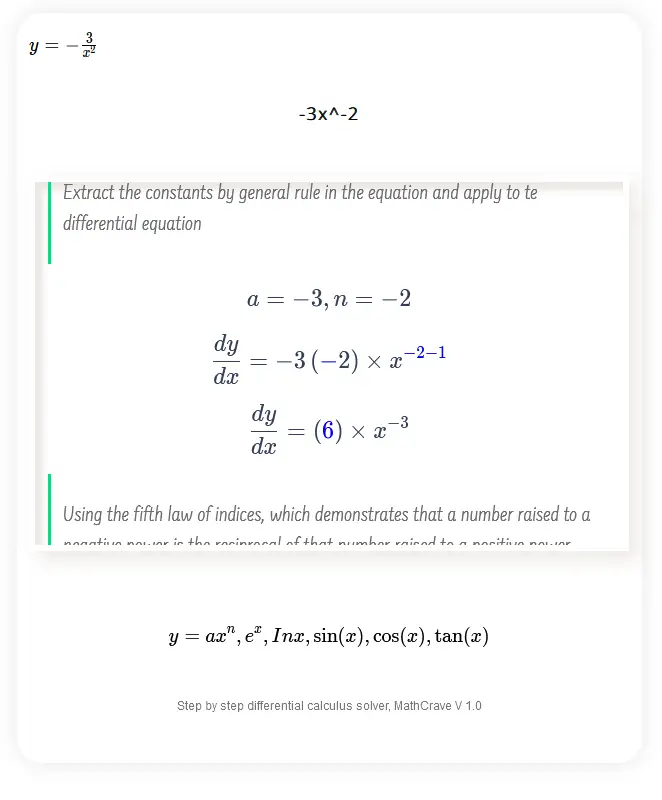Solves differentiation of a single block... \[x^2, 3x^2, sin(3x)\]

10
10x
-10
-10x
x^(1/2)
x^-(1/2)
4x^-(1/2)
5x^(1/2)
-25x^(1/2)
e^x
e^3x
-e^x
-e^-x
-e^-(5x)
e^-(5x)
e^(25x)
4e^5x
6e^(1/2x)
-12e^(1/2x)
-2e^-(1/2x)
Inx
In9x
8Inx
12In4x
-12Inx
-14In8x
sin(x)
cos(x)
tan(x)
2sin(x)
4sin(3x)
-12cos(9x)
To find the differential coefficient of each given function, the math solver uses the basic rules of differentiation
The power rule states that if we have a function of the form y = ax^n, then its derivative is given by
dy/dx = anx^(n-1).
Using this rule, we can find the derivative of y =12x^3 as follows:
dy/dx =3 *12x^(3-1)
dy/dx = 36x^2
The differential coefficient of y =12x^3 is dy/dx =36x^2
The derivative of the exponential function e^x is itself, so we can differentiate
y =4e^(3x) as follows:
dy/dx =4 * d/dx(e^(3x))
dy/dx =4 *3e^(3x)
dy/dx =12e^(3x)
Therefore, the differential coefficient of y =4e^(3x) is dy/dx =12e^(3x)
The derivative of the natural logarithm function ln(x) is 1/x,
so we can differentiate y = ln (4x) as follows:
dy/dx = d/dx(ln(4x))
dy/dx =1/(4x) * d/dx(4x)
dy/dx =1/(4x) *4
dy/dx =1/x
Therefore, the differential coefficient of y = ln(4x) is dy/dx =1/x
The derivative of the sine function sin(x) is the cosine function cos(x). Using the chain rule, we can differentiate
y = sin(5x) as follows:
dy/dx = d/dx(sin(5x))
dy/dx = cos(5x) * d/dx(5x)
dy/dx =5cos(5x)
The differential coefficient of y = sin(5x) is dy/dx =5cos(5x).
In summary:
The differential coefficient of y =12x^3 is dy/dx =36x^2
The differential coefficient of y =4e^(3x) is dy/dx =12e^(3x).
The differential coefficient of y = ln(4x) is dy/dx =1/x
The differential coefficient of y = sin(5x) is dy/dx =5cos(5x).
